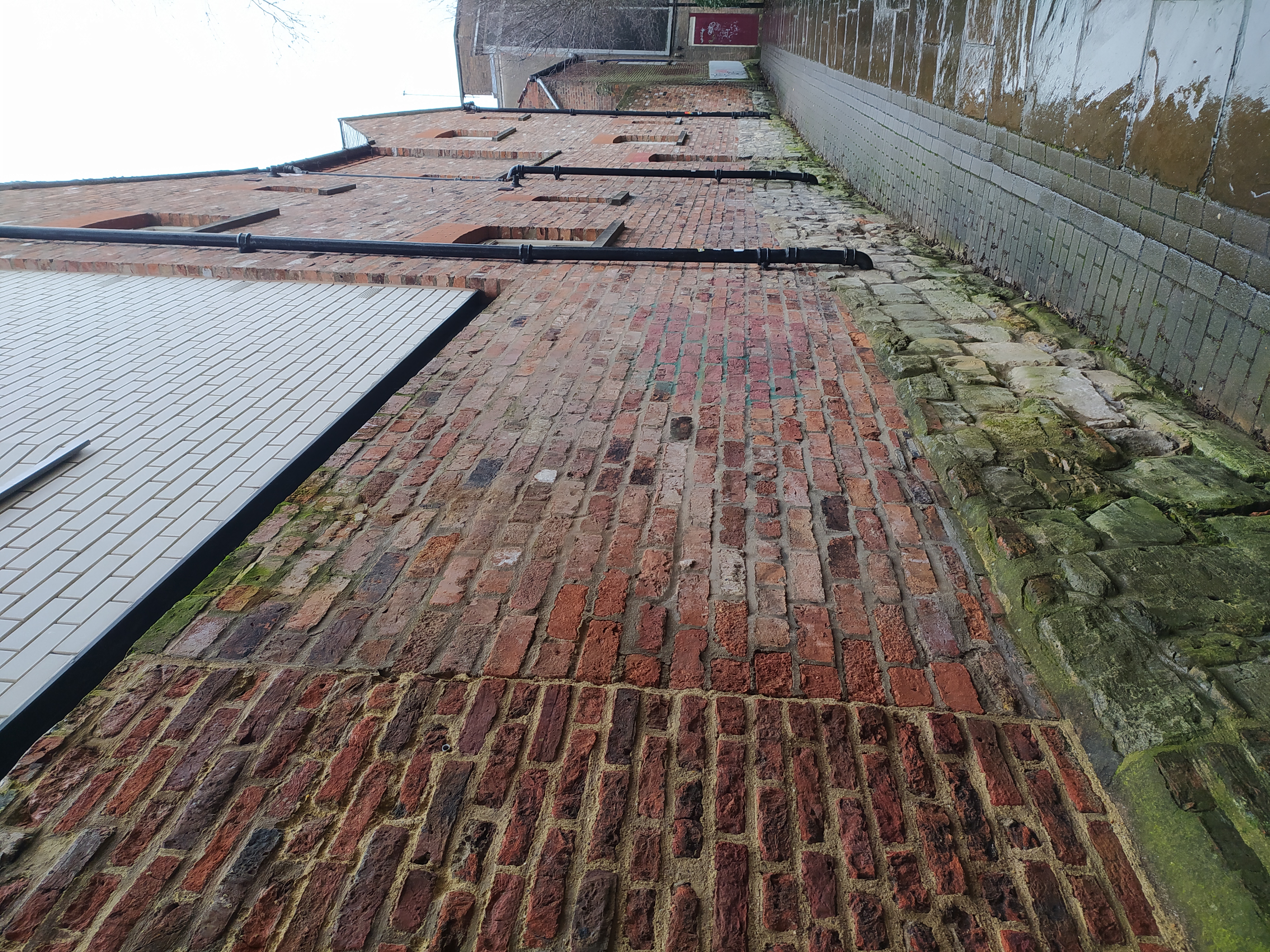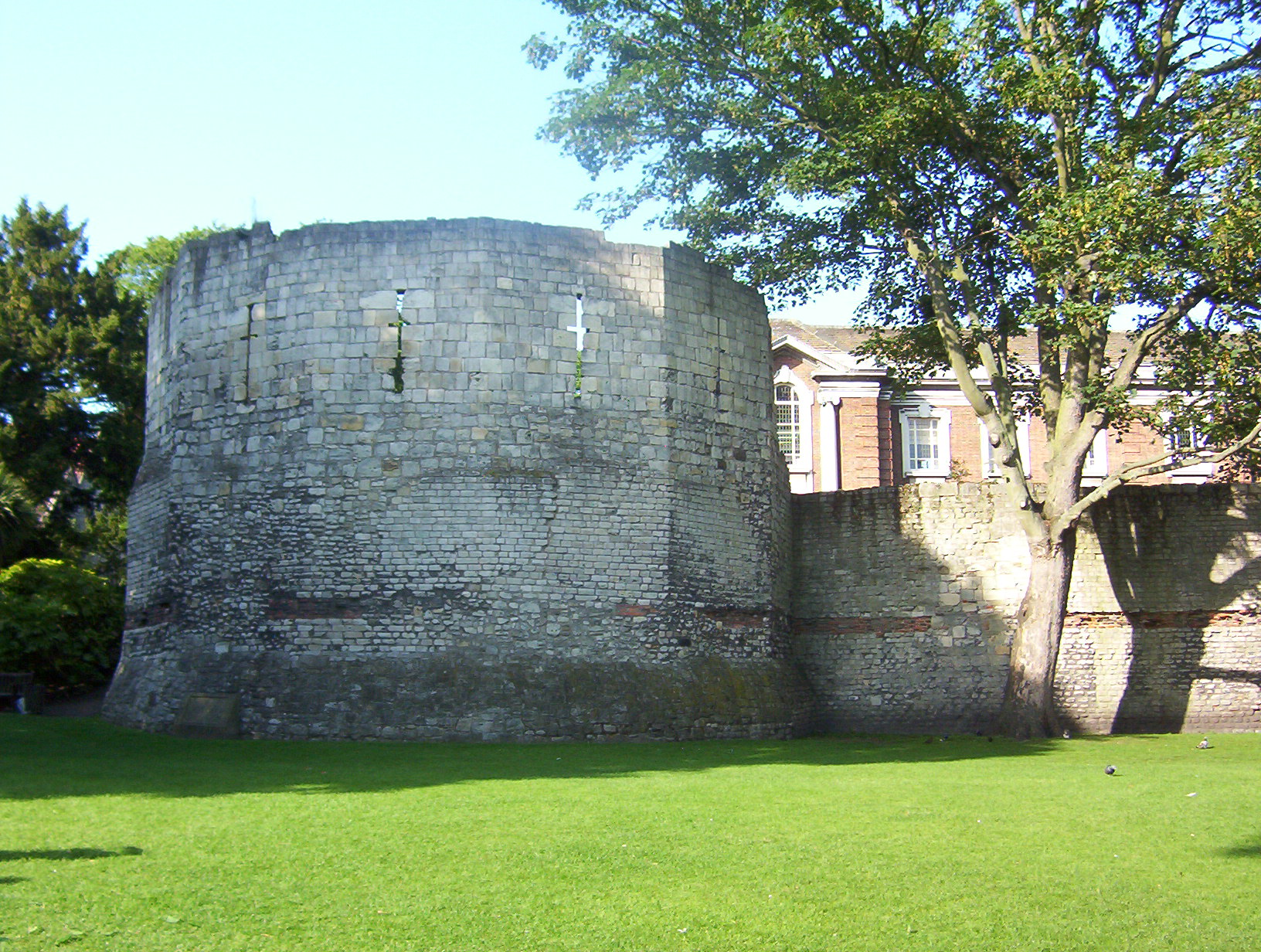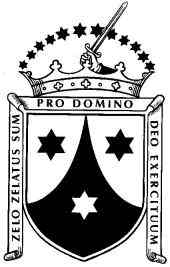|
York Carmelite Friary
York Carmelite Friary was a friary in York, North Yorkshire, England, that was established in about 1250, moved to its permanent site in 1295 and was surrendered in 1538. The original site was on Bootham in York until 1295 when William de Vescy gave the Carmelite friars a tenement in Stonebow Lane which extended as far south as the River Foss and from east to west between the streets of Fossgate and 'Mersk'. Within five years the friary church was under construction followed by the consecration of a cemetery in 1304 and the church in 1328. A royal licence was granted in 1314 that allowed the friars to build a quay on the Fishpond of the Foss and keep a boat that enabled the transporting of building materials. This licence and the gift of additional lands was followed by a number of extensions that took place throughout the 14th century culminating in the rebuilding of the church in 1392 as the friary eventually extended as far east as Hungate. The location of friary land within ... [...More Info...] [...Related Items...] OR: [Wikipedia] [Google] [Baidu] |
York Camelite Friary Wall
York is a cathedral city with Roman origins, sited at the confluence of the rivers Ouse and Foss in North Yorkshire, England. It is the historic county town of Yorkshire. The city has many historic buildings and other structures, such as a minster, castle, and city walls. It is the largest settlement and the administrative centre of the wider City of York district. The city was founded under the name of Eboracum in 71 AD. It then became the capital of the Roman province of Britannia Inferior, and later of the kingdoms of Deira, Northumbria, and Jórvík, Scandinavian York. In the Middle Ages, it became the Province of York, northern England ecclesiastical province's centre, and grew as a wool-trading centre. In the 19th century, it became a major railway network hub and confectionery manufacturing centre. During the Second World War, part of the Baedeker Blitz bombed the city; it was less affected by the war than other northern cities, with several historic buildings be ... [...More Info...] [...Related Items...] OR: [Wikipedia] [Google] [Baidu] |
Yorkshire Museum
The Yorkshire Museum is a museum in York, England. It was opened in 1830, and has five permanent collections, covering biology, geology, archaeology, numismatics and astronomy. History The museum was founded by the Yorkshire Philosophical Society (YPS) to accommodate their geological and archaeological collections, and was originally housed in Ousegate, York, until the site became too small. In 1828, the society received by royal grant, of land formerly belonging to St Mary's Abbey for the purposes of building a new museum. The main building of the museum is called the Yorkshire Museum; it was designed by William Wilkins in a Greek Revival style and is a Grade I listed building. It was officially opened in February 1830, which makes it one of the longest established museums in England. A condition of the royal grant was that the land surrounding the museum building should be a botanic gardens and one was created in the 1830s. The botanic gardens are now known as the Museum G ... [...More Info...] [...Related Items...] OR: [Wikipedia] [Google] [Baidu] |
Carmelite Monasteries In England
, image = , caption = Coat of arms of the Carmelites , abbreviation = OCarm , formation = Late 12th century , founder = Early hermits of Mount Carmel , founding_location = Mount Carmel , type = Mendicant order of pontifical right , status = Institute of Consecrated Life , membership = 1,979 (1,294 priests) as of 2017 , leader_title = Motto , leader_name = la, Zelo zelatus sum pro Domino Deo exercituumEnglish: ''With zeal have I been zealous for the Lord God of hosts'' , leader_title2 = General Headquarters , leader_name2 = Curia Generalizia dei CarmelitaniVia Giovanni Lanza, 138, 00184 Roma, Italia , leader_title3 = Prior General , leader_name3 = Mícéal O'Neill, OCarm , leader_title4 = Patron saints , leader_name4 = Our Lady of Mt. Carmel, Elijah , parent_organization = Catholic Church , website = ... [...More Info...] [...Related Items...] OR: [Wikipedia] [Google] [Baidu] |
Monasteries In North Yorkshire
A monastery is a building or complex of buildings comprising the domestic quarters and workplaces of Monasticism, monastics, monks or nuns, whether living in Cenobitic monasticism, communities or alone (hermits). A monastery generally includes a place reserved for prayer which may be a chapel, Church (building), church, or temple, and may also serve as an Oratory (worship), oratory, or in the case of Cenobium, communities anything from a single building housing only one senior and two or three junior monks or nuns, to vast complexes and estates housing tens or hundreds. A monastery complex typically comprises a number of buildings which include a church, dormitory, cloister, refectory, library, Wiktionary:balneary, balneary and Hospital, infirmary, and outlying Monastic grange, granges. Depending on the location, the monastic order and the occupation of its inhabitants, the complex may also include a wide range of buildings that facilitate self-sufficiency and service to the com ... [...More Info...] [...Related Items...] OR: [Wikipedia] [Google] [Baidu] |
Thomas Bardolf, 5th Baron Bardolf
Thomas Bardolf, 5th Baron Bardolf (22 December 1369 – 19 February 1408) was a baron in the Peerage of England, Lord of Wormegay, Norfolk, of Shelford and Stoke Bardolph in Nottinghamshire, Hallaton (Hallughton), Leicestershire, and others, and was "a person of especial eminence in his time". A supporter of the rebellion of Henry Percy, 1st Earl of Northumberland, against King Henry IV of England after the death of Percy's son Harry Hotspur, he died from wounds received at the Battle of Bramham Moor. Life The eldest son of William 4th Lord Bardolf, Knight, of Wormegay and his wife Agnes de Poynings, Thomas Bardolf de Wormegay, 5th Baron Bardolf, was summoned to the Parliament of England from 12 September 1390 to 25 August 1404. He took part with Henry Percy, 1st Earl of Northumberland, and others, in their insurrection against King Henry IV, and being pursued by the Royal army in great force, was obliged to flee to France. But about three years after returning to England ... [...More Info...] [...Related Items...] OR: [Wikipedia] [Google] [Baidu] |
University Of York
, mottoeng = On the threshold of wisdom , established = , type = Public research university , endowment = £8.0 million , budget = £403.6 million , chancellor = Heather Melville , vice_chancellor = Charlie Jeffery , students = () , undergrad = () , postgrad = () , city = Heslington, York , country = England , campus = Heslington West, Heslington East, and King's Manor , colours = Dark blue and dark green , website = , logo = UoY_logo_with_shield_2016.png , logo_size = 250px , administrative_staff = 3,091 , affiliations = The University of York (abbreviated as or ''York'' for post-nominals) is a collegiate research university, located in the city of York, England. Established in 1963, the university has expanded to more than thirty departments and centres, covering a wide range of subjects. Situated to the south-east of the city of York, the university campus is about in size. The original campus, Campus West, incorporates the York Sci ... [...More Info...] [...Related Items...] OR: [Wikipedia] [Google] [Baidu] |
More House
More House is the Catholic chaplaincy for the University of York in Heslington, York. The building itself dates from the late 18th century. The chaplains were formerly Carmelite friars resident in the building, but since 2021 priests from York Oratory have been ministering to the chaplaincy. It is located on Main Street in Heslington, which is towards the south edge of "Campus West". It is a Grade II listed building. History In the late 18th century, the house was constructed. From 1809 to 1814, Sydney Smith lived there while his rectory in Foston was being rebuilt. From 1869, the parish of St Paul's Church in Heslington had a vicar and the house later became a vicarage. At some point later, the house became owned by the Diocese of Middlesbrough and renamed More House after Saint Thomas More. In 1967, the Catholic chaplaincy was started at More House. From 1995 to 2021 the Carmelites served as chaplains to the Catholic community of the University of York. The Carmelites prev ... [...More Info...] [...Related Items...] OR: [Wikipedia] [Google] [Baidu] |
Diocese Of Middlesbrough
The Roman Catholic Diocese of Middlesbrough is a Latin Rite Roman Catholic diocese based in Middlesbrough, England and is part of the province of Liverpool. It was founded on 20 December 1878, with the splitting of the Diocese of Beverley which had covered all of Yorkshire. The Bishop's See is in Coulby Newham, Middlesbrough, at St Mary's Cathedral. History The diocese was created on 20 December 1878, when the then Diocese of Beverley, which covered the whole of Yorkshire, was divided into the Diocese of Middlesbrough, covering the North and East Ridings of Yorkshire and those parishes in the City of York to the north of the River Ouse, and the Diocese of Leeds, covering the West Riding of Yorkshire and those parishes in the City of York to the south of the River Ouse. In 1982 the two York parishes south of the River Ouse were ceded to the Diocese of Middlesbrough to unite the City of York under one bishop. The parish of Howden was transferred from Middlesbrough to the Leeds ... [...More Info...] [...Related Items...] OR: [Wikipedia] [Google] [Baidu] |
York Press
''The Press'' is a local, daily, paid for, newspaper, for North and East Yorkshire. It is published in the City of York by Newsquest Media Group Ltd, a subsidiary of Gannett Company Inc. The ''Yorkshire Evening Press'' was established in 1882. It changed from broadsheet to compact format in 2004 and shortly afterwards dropped "Yorkshire" from the title. Morning printing began on 24 April 2006, and the paper was given its present name. William Wallace Hargrove printed at 9 Coney Street. Paper was delivered by barge Barge nowadays generally refers to a flat-bottomed inland waterway vessel which does not have its own means of mechanical propulsion. The first modern barges were pulled by tugs, but nowadays most are pushed by pusher boats, or other vessels. ... along the River Ouse. In 1989, publication moved to Walmgate. ''The Press'' has run campaigns including their ''Guardian Angels Appeal'' and ''Change It''. Circulation ABC print circulation for second half o ... [...More Info...] [...Related Items...] OR: [Wikipedia] [Google] [Baidu] |
Edward Baines (1774–1848)
Edward Baines (1774–1848) was the editor and proprietor of the '' Leeds Mercury'', (which by his efforts he made the leading provincial paper in England), politician, and author of historical and geographic works of reference. On his death in 1848, the ''Leeds Intelligencer'' (a rival of the ''Mercury'', and its political opponent for over forty years) described his as "one who has earned for himself an indisputable title to be numbered among the notable men of Leeds". Of his character and physical appearance it remarked: "Mr Baines had great industry and perseverance, as well as patience and resolution; and with those he possessed pleasing manners and address, - that debonair and affable bearing, which conciliated even those who might have felt that they had reason to regard him as an enemy… In person he was of a firm well-built frame, rather above the average stature; his features were regular, his expression of countenance frank and agreeable; and he retained his personal ... [...More Info...] [...Related Items...] OR: [Wikipedia] [Google] [Baidu] |
John Speed
John Speed (1551 or 1552 – 28 July 1629) was an English cartographer, chronologer and historian of Cheshire origins.S. Bendall, 'Speed, John (1551/2–1629), historian and cartographer', ''Oxford Dictionary of National Biography'' (OUP 2004/2008); superseding A.F. Pollard, 'Speed, John (?1552-1629), historian and cartographer', ''Dictionary of National Biography'' (1885-1900)vol. 53 The son of a citizen and Merchant Taylor in London,"Life of John Speed", ''The Hibernian Magazine, Or, Compendium of Entertaining Knowledge'', July 1782p. 348(Google). he rose from his family occupation to accept the task of drawing together and revising the histories, topographies and maps of the Kingdoms of Great Britain as an exposition of the union of their monarchies in the person of King James I and VI. He accomplished this with remarkable success, with the support and assistance of the leading antiquarian scholars of his generation. He drew upon and improved the shire maps of Christopher ... [...More Info...] [...Related Items...] OR: [Wikipedia] [Google] [Baidu] |
William Melton
William Melton (died 5 April 1340) was the 43rd Archbishop of York (1317–1340). Life Melton was the son of Nicholas of Melton, and the brother of Henry de Melton, and John Melton. He was born in Melton in the parish of Welton, about nine miles from Kingston upon Hull. He was a contemporary of John Hotham, Chancellor of England and Bishop of Ely. The two prelates were often associated in public matters and were the most powerful churchmen of their period in England. Melton was Controller of the Wardrobe at the accession of Edward II in 1307 and was a pluralist through and through at the time of his elevation to the see of York. Among other things, he was also Archdeacon of Barnstaple and Provost of Beverley. He was Lord Privy Seal from 1307 to about 1312, having been Dean of St. Martin's-le-Grand at that time also.Fryde, et al. ''Handbook of British Chronology'' p. 93 He was promoted to Keeper of the Household Wardrobe from 1314 to 1316. He was elected by the cha ... [...More Info...] [...Related Items...] OR: [Wikipedia] [Google] [Baidu] |








